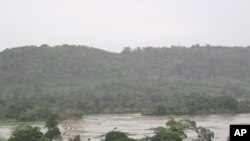A tropical cyclone that hit Madagascar on Monday has brought damage and flooding to towns and villages in the northeast of the country and killed at least six people. Relief workers are still assessing the damage but reports indicate that flooding to houses, roads and crops in the pre-harvest, so-called lean season, could lead to food shortages in the area. Our reporter visited the devastated region earlier this week and reports from Madagascar's capital, Antananarivo.
Tropical Cyclone Bingiza struck the village of Vinanivao on the northeast coast of Madagascar around dawn on Monday morning. Authorities say there were winds of up to 180 kilometers per hour, and more than 600 homes were destroyed, leaving thousands without proper shelter.
Damage to the bridge and road has left the small fishing village cut off from food markets The cyclone also damaged more than 200 other buildings and ruined about 500 hectares of rice just months away from harvest.
While official evaluations are carried out in the farming region, helicopter assessments of the worst hit areas surrounding Vinanivao show widespread damage, with houses crushed and missing roofs and crops battered by winds or floods.
Nurse Jean Michel from a village inland said the cyclone had stranded nearby villages and ruined crops.
Michel said the storm came from the east with heavy rain and such strength it damaged crops.
Charity CARE International’s Emergency and Disaster Relief Coordinator, Didier Young, said although the category-two cyclone has not done as much structural damage as expected, flooding to rice paddies could mean food shortages this year.
"If a cyclone hits at the beginning of the season, it is still possible with short cycle varieties to replant, but after the beginning of February it’s becoming almost impossible, because it’s not going to grow," said Young. "It’s going to get cold before the plants produce grain, so there will be no harvest."
CARE’s Head of Project, Dasy Ibrahim in Antalaha, a coastal city in northeast Madagascar, said damage to short cycle crops and trees during the lean season, when supplies of food and money are at their lowest until the main harvest in April, could make the food shortages immediate.
Ibrahim says things people live off during the lean season, like manioc, bananas, and fruits, have been knocked to the ground by the cyclone and they can't get them back immediately because it takes a year for a banana tree to regrow and manioc rots week by week so people aren't going to have much to eat.
The only thing left for farmers whose rice harvest is destroyed is to use seeds from relief groups to plant corn, but those living off cash crops such as cloves, vanilla and coffee destroyed by strong coastal winds would be seriously affected.
Relief agencies will deliver plastic sheeting and food supplies via boat to the worst hit areas of northeast Madagascar that have been cut off, and rebuild the houses of the most vulnerable who cannot seek out new materials from the forests.
NGOs Assess Damage After Tropical Cyclone Hits Madagascar








